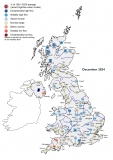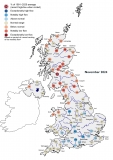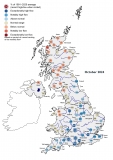Missing periods
A table of missing data periods is provided for each station, listing the start and end dates of all clearly identified periods of missing data and their length in whole days. Gaps in the pre-digital record which may not be so clearly identified, are not listed.
Missing periods are shown on the AMAX and POT plots with yellow shading and may result from technical issues, for example, with the telemetry system, or from temporary closure of the station for improvement works.
Work to update the tables of missing periods is ongoing. This means that some periods identified as missing have subsequently been infilled.
Unrepresentative periods
These are shown on the AMAX and POT plots with pink shading and indicate that the data collected during this period is not representative of the catchment or is inconsistent with the remainder of the data. This may result from a change in the catchment and runoff pattern, for example, if a large reservoir was built causing a change in FARL value, or from periods of poor data quality during the period of record. Data recorded during unrepresentative periods are rejected, and the indicative suitability is based on the remainder of the data, providing the length of record is reasonable.
Rejected data
Rejected data that are unsuitable for use in flood estimation can arise from either missing or unrepresentative periods. These are shown as red AMAX bars and red POT cross on the plots, and listed in the AM and PT file downloads for use in WINFAP-FEH.
All POTs recorded during an unrepresentative period are rejected. The AMAX for a given water year will be rejected if part of the record for that water year is either missing or unrepresentative, and the true AMAX is thought to have occurred during that period. By default, rejected data are excluded from analysis within WINFAP, although the user can choose to include them.



